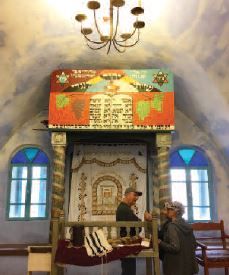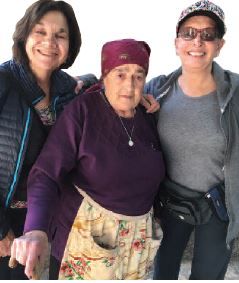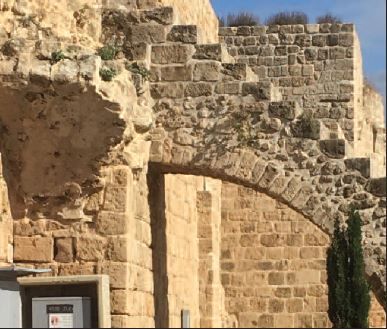Great Weekend in Old Peki’in
Just before Chanukah, we drove to the Upper Galilee on beautiful mountain roads to visit the village of Peki'in. According to Jewish Virtual Library, Peki'in can possibly be identified with Baca (or Beqa'), the town which marks the boundary between the Upper and Lower Galilee. Fragments of reliefs with Jewish symbols are found dispersed in the village, dating from the late Roman period. Beqa' was the place where Rabbi Shimon bar Yoḥai (known as Rashbi) and his son Rabbi Eleazar lived in a cave for 13 years around the time of the Bar Kokhba Revolt (132–35), when Israel's defeat at Roman hands provoked the expulsion of most Jews from the Land of Israel. The cave later became a pilgrimage site for Jews and non-Jews alike. In the Midrash (oral discussions about the Torah which later were written down) the place is called Peki'in.
"Peki'in is a story of harmony, a village where Christian Arabs, Druze and one [remaining] ancient Jewish family have lived peacefully together for centuries. Peki'in was a farming village since the time of the Second Temple 2,000 years ago. Since that time only one Jewish family has stayed in place. Arab settlement in Peki'in started in the 11th century CE with Arab Christians who were joined a century later by Crusaders. In the 18th century Druze families moved into the village [and now are the majority there]. (jewishvirtuallibrary.org)
Today, Peki'in is a popular tourist spot for Israelis. You can easily spend a half day (after wending your way there on tiny, congested streets) in the quaint touristic center of the town, where there is at least one good restaurant, an excellent museum/film of Jewish history, and a synagogue, now used for special occasions, such as barmitzvahs, brits, and weddings.
We booked rooms for the night at the Peki'in Hostel, which provided comfortable accommodations and a good Shabbat meal and breakfast, at a reasonable price. The town of about 4,000 people is mostly comprised of Druze Israelis, although there are Muslims and Christian Israelis too. The Jewish population, which at one time was large, has dwindled to just the chatty octogenarian Margalit Zinati, who maintains the synagogue and museum with help from a younger cousin. In 1871, the synagogue was built with funds provided by a wealthy Jew from Beirut. Allegedly, the synagogue includes one wall from the original Second Temple period structure. The synagogue was renovated in 1926 and 1956, as well as the recent refurbishment.
After breakfast, we drove down from the mountainous redoubt of Peki'in to the Mediterranean coast. We were on our way to visit Akko, the location of the Crusader city of Acre—a UNESCO world heritage site. A small city just north of Haifa, Akko has been continuously inhabited for thousands of years. It's colorful history stretches back at least 5,000 years to the Early Bronze Age settlement of Tel Akko. Later, it became a Canaanite Iron Age town which was closely allied with the Phoenicians and later ruled by a governor appointed by King Solomon; various incarnations under the Persian, Ptolemy, and Seleucid Empires; Greek rule, which was upended by the Maccabi (Hasmonean) Dynasty; the Pax Romana which lasted for centuries; Crusaders and Muslims fighting for control of the vicinity; Ottoman Empire rule for four centuries, from 1517 to 1917; and lastly the British Mandate period until 1948. During Israel's War of Independence, the Jews regained sovereignty over Akko.
With its waterfront walled city and lauded history, tourism is a big part of Akko's economy. Its progressive mayor, Shimon Lankri, has worked wonders in the last few years to clean up and revitalize this mixed city, which has a predominantly Jewish population. Skipping the fantastic Crusader/Ottoman reconstructions as it requires at least a half day to explore, we were more than satisfied to simply walk through the colorful shuk and the adjacent port. We were amazed by the cleanliness and increased touristic activity since our last visit several years ago.
Our objective was a great lunch overlooking the sea. Skipping the restaurants in the central port area, which were spoiled for us by the loudspeakers of competing companies trumpeting their fast motor boat rides, we carried on, further away from the shuk. We were amply rewarded by finding a table with a beautiful view at an excellent restaurant. Our freshly caught fish platters were delicious and we enjoyed our afternoon coffee right there.
Stopping in the shuk on our way back to the car, I had my pick of the many delicious nut candies which were featured among the food delicacies and other, sundry goods. We then made our way south homeward without too much traffic. It was a great, quick weekend in Israel's fabulous north. Check out Akko's terrific website at akko.org.il to wet your appetite to visit this ancient city.











Comments